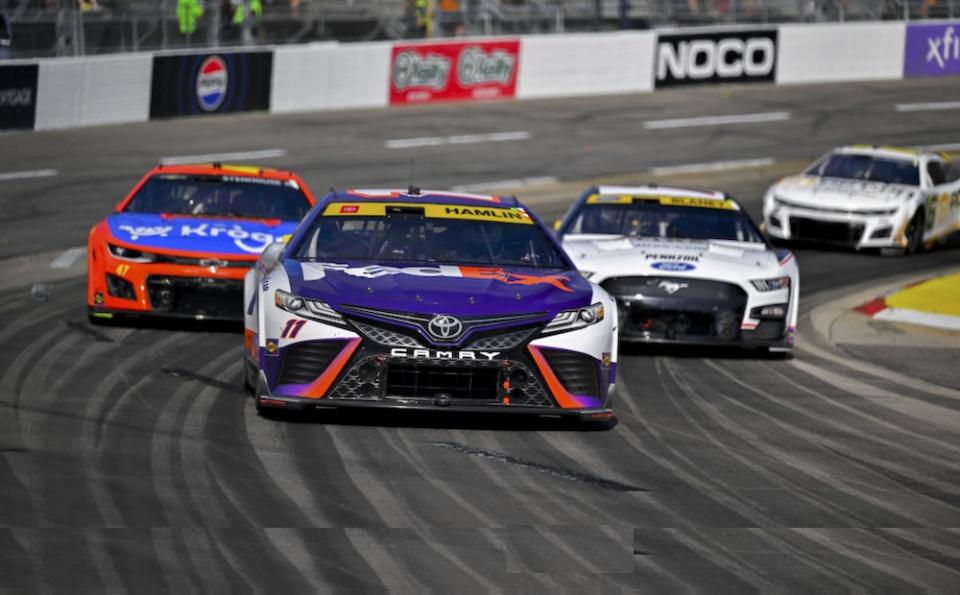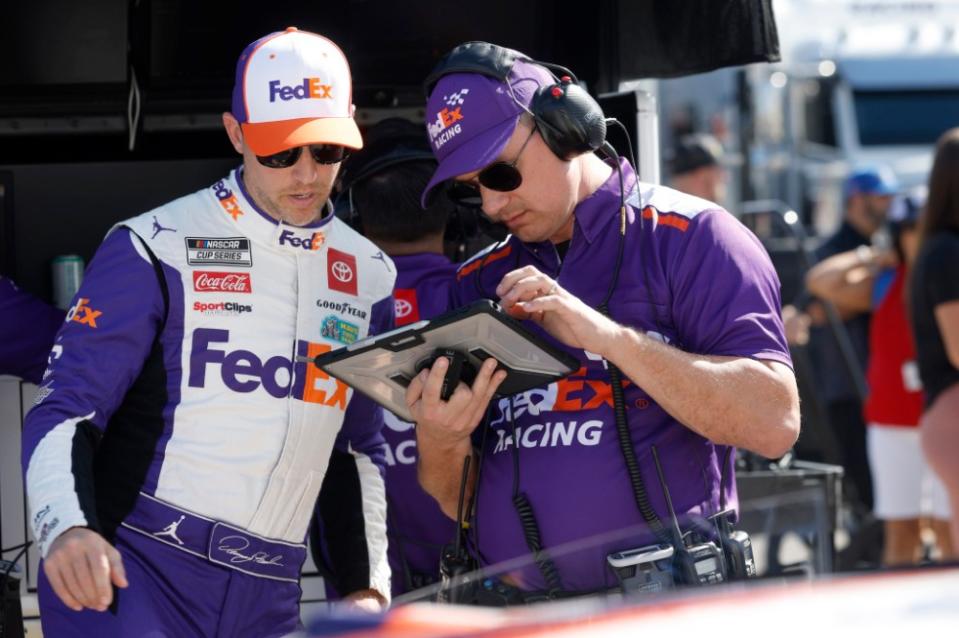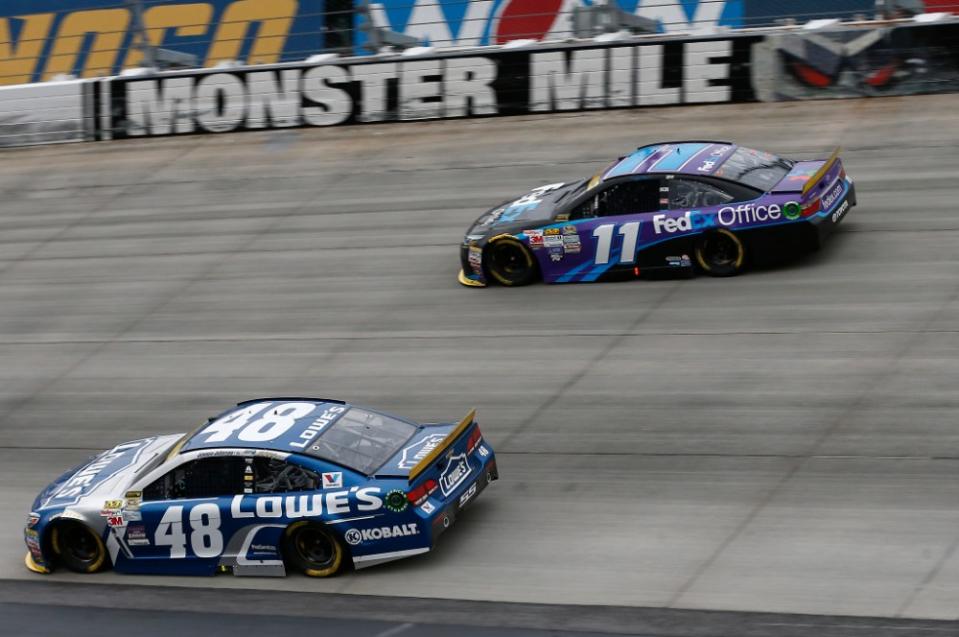How seat time and savvy deal Hamlin a winning hand

Denny Hamlin started his 19th season in the NASCAR Cup Series with a victory last Saturday night in the Busch Light Clash at the Coliseum that highlighted the benefits of his experience as well as his natural gifts.
Hamlin, driver for Joe Gibbs Racing and co-owner of 23XI Racing, has compiled a Hall of Fame résumé. The Clash was his ninth victory in a non-points event, which includes the All-Star Race, Daytona qualifying race and Clash events. Officially, Hamlin has 51 victories in the Cup Series.
The 43-year-old can get it done on the racetrack and articulately explain how it happened when behind the microphone. Hamlin always draws a crowd and now has a podcast, Action Detrimental, where he shares insight on his No. 11 team, his competition and the sport.
That insight is the product of a high racing IQ, which can manifest as race craft — like taking a car that isn’t the best that weekend and succeeding — and an understanding of how the sport works. Hamlin is well-versed in dissecting how his race played out and what happened to others. And he can adjust his presentation depending on whether he’s talking as a driver, or just an interested observer.
“I usually know within the first 10 laps whether I have a car that’s capable of winning or not,” Hamlin says of how his focus changes during a race. “Most weekends, fortunately for me, I know that we do. But if I go to a track that I know that I’ve got a great history at, great feel at, I know my car is going to be fast that weekend. And there’s things we know, because our team tells us, ‘Hey, we’ve gained a little bit; you’re going to the track with a little bit more than what you had last time.’
“I’ll run the first 10 laps and it doesn’t matter if I qualified 26th that weekend, I’ll maneuver and be like, ‘Oh, boy.’ I knew it at — maybe it was Kansas in the playoffs — I was like, ‘I’m back here in 10th, but they don’t know what’s coming.’ I (clocked) how many laps we had left, how many pits stops we had left. I know I’m going to make it to the front. It’s just a matter of time.”
Being able to stay on top of what his car is doing and see the trends around him amid the chaos of competition has been invaluable to Hamlin. For instance, he knows that the first drivers to take their cars to the top of the track are going to run fast. There are times when a driver might run a different line in practice which proves fast, but that isn’t where the field will run during the race.
“It’s taking that information and not panicking with it and trusting past experience, trusting what you’ve got, you’re going to be successful with,” Hamlin says. “You don’t need to alter your strategy or alter your driving style because someone else is running faster for a five-lap period. I know over the long term, with a big enough sample size, by the end of the race we’re going to be there.”
While the driver’s role might be more important than ever, Hamlin – here crunching numbers with his Joe Gibbs Racing crew chief Chris Gabehart – feels applying data effectively is just as critical to success. Matt Thacker/Motorsport Images
So much has changed around Hamlin since he was a rookie in 2006. There are new racetracks, the cars have gone through multiple iterations, and of course, there has been continual change in policy and procedure. What goes into staying one of the top drivers in the sport has changed, too.
Telemetry from SMT Data is a well-known tool in the garage for information such as steering inputs, throttle traces and brake use. It used to be restricted within each race team until NASCAR made the information readily available for all to see beginning in 2018. That has allowed drivers to see what the competition is doing.
Hamlin initially didn’t like having his proprietary information given away. Then he realized it could be used to his advantage by studying the drivers who were better at tracks where he was still struggling.
“Now, everyone can open the app. It’s knowing how to use it,” Hamlin notes. “It’s knowing what to look for and at the beginning, let’s just say six, seven years ago, I had to manually go in and look at what I think I needed to improve on. What’s changed is, teams are smarter — they force-feed you where you need to get better, and then give me the tools to go make it better.
“At Joe Gibbs Racing, I’m a large part of developing new tools. How do we get information faster and better and more concise? What took me eight minutes to find, how can I find it in five? I think those are difference-makers that ultimately always give me an edge. I’m not just using the tools; I’m helping develop them.”
Studying is one thing. Understanding and retaining the information and specific details is another.
“I can sit with one person and say, ‘Here’s the playbook that I feel like I’ve been successful at, here’s the things that I look at, here’s the things that I study, here’s the things to watch out for,’” Hamlin says. “It may not work for them. I think it’s specific and individual to the person. I was never good in school, I really wasn’t. It didn’t interest me — racing did. All I cared about was getting through school so I could go racing on the weekend.
“In school, my teachers had to put things in racing terms for me to retain it because they knew that I would not have otherwise.”
As the Cup Series car becomes more homogeneous, the more important the driver becomes. Hamlin never stops working on his craft or finding ways he can make the difference behind the wheel. Talent, he feels, can only take you so far.
“I think that my racing IQ — not just on the racetrack but off the racetrack, learning what I need to be better — will continue to put me in the upper echelon of the most talented guys,” he says. “I don’t out-study guys and I don’t think I put in more time than them, but it’s understanding what to look for and what gray areas can I exploit?
“People make fun of me for speeding on pit road, but I was the first guy back in the day that said, ‘Wait a minute, so the speed limit is 35 but they let you run 40? Why don’t you just set my lights to 40?’ Then we would just we smash people for a year on pit road back in 2007 or so. It’s just finding those areas and there are still areas to gain at even though things have become more common than ever. We run up front every week because of the process my team has and the process that I have to prepare and be ready.”
Seeing what Jimmie Johnson was doing at Dover wasn’t enough for Hamlin to emulate his success there, until he realized it required a complete overhaul of his approach. Brett Moist/Motorsport Images
If success is where opportunity meets preparation, studying drivers who are exceptional at certain tracks has been beneficial. One example Hamlin gives is Jimmie Johnson at Dover. Johnson won 11 times at Dover no matter the car, format, tires, or any other variable. So, whatever his approach was, was clearly the correct one and Hamlin wanted to emulate it.
For much of Hamlin’s career, he couldn’t wrap his arms around the place. It wasn’t for a lack of effort: Hamlin studied Johnson’s in-car and roof cameras, but while he could see what Johnson was doing, he couldn’t see how he was doing it, until he realized it required a complete overhaul of his approach.
“The moment I saw how he was doing it is when the light switch went off to me and I went into practice the next day and said, ‘I am going to forget what I think I need to do to make speed. I’m going to just make speed doing what he did,’” Hamlin recalls. “What I found is, wow, I needed a car to drive totally different to do this. As soon as I started matching the style to the car, bam, we took off. That was one where for 10, 15 years, I had the wrong approach and when I studied the right approach, and then matched my car to fit that, we took off.”
Despite all of this, there are times when Hamlin’s racing IQ works against him. The aforementioned Kansas race was one that got away simply because Hamlin overthought it. On the final restart, Hamlin lined up third in the outside row, in a good spot with fresh tires, but became too focused on Kyle Larson behind him.
Because he understood restarts and the styles of his competitors, Hamlin knew Larson was going to lag back for an advantage. When the green flag flew for the restart, Hamlin was sleeping. He could only get back to second. There’s another race from late last year that also comes to mind for him.
“Talladega,” Hamlin says. “I sped on pit road because I was paranoid about getting run into from behind. I’m looking up like, ‘Don’t run into me and oh, (expletive), I missed my lights.’ I do it all the time. I think if I had two shots at every race, we would win a lot [more] because you can just see things coming and to me, you win a lot because you are prepared for situations that others are not prepared for.
“The reason I think I’ve had a rejuvenation of my career in the later stages is that I have experience. If you were able to mix experience and the ability to continue to learn, you’d get a really, really potent combination. Ty Gibbs, while he probably does more work than I do, he still doesn’t have the experience and that goes a really, really long way.”
Hamlin has grown as a driver on and off the track, and all of that knowledge has made him one of the best in the business.
“All the knowledge of needing to be looking out for this, that and the other, and I’m willing to put in the work and still change how I drive 20 years into this,” he says. “That’s what makes it successful.”

 Yahoo Autos
Yahoo Autos 

